Charles Sturt University ITC595 Research: Cloud Computing Security
VerifiedAdded on 2022/10/04
|6
|2247
|27
Project
AI Summary
This research project delves into the realm of cloud computing security, examining various threats and vulnerabilities inherent in cloud environments. The study begins with an overview of cloud computing, its benefits, and the increasing reliance of businesses on cloud services. It then identifies key research questions, focusing on the threats faced by cloud computing, their evolution, and effective preventive measures. A literature review explores various security threats, including data loss, insecure APIs, and lack of user awareness. The project also highlights challenges related to data privacy, system control, and distributed computation. The research further investigates preventative methods, such as user education, fragmentation redundancy scattering, security plans, and hybrid solutions. Access control, multi-factor authentication, and choosing the right hosting provider are also discussed as vital steps in minimizing cloud computing threats. The project concludes by emphasizing the importance of a proactive approach to cloud security, advocating for continuous evaluation of risks and benefits, and the implementation of robust security measures to protect data and maintain a secure computing environment.
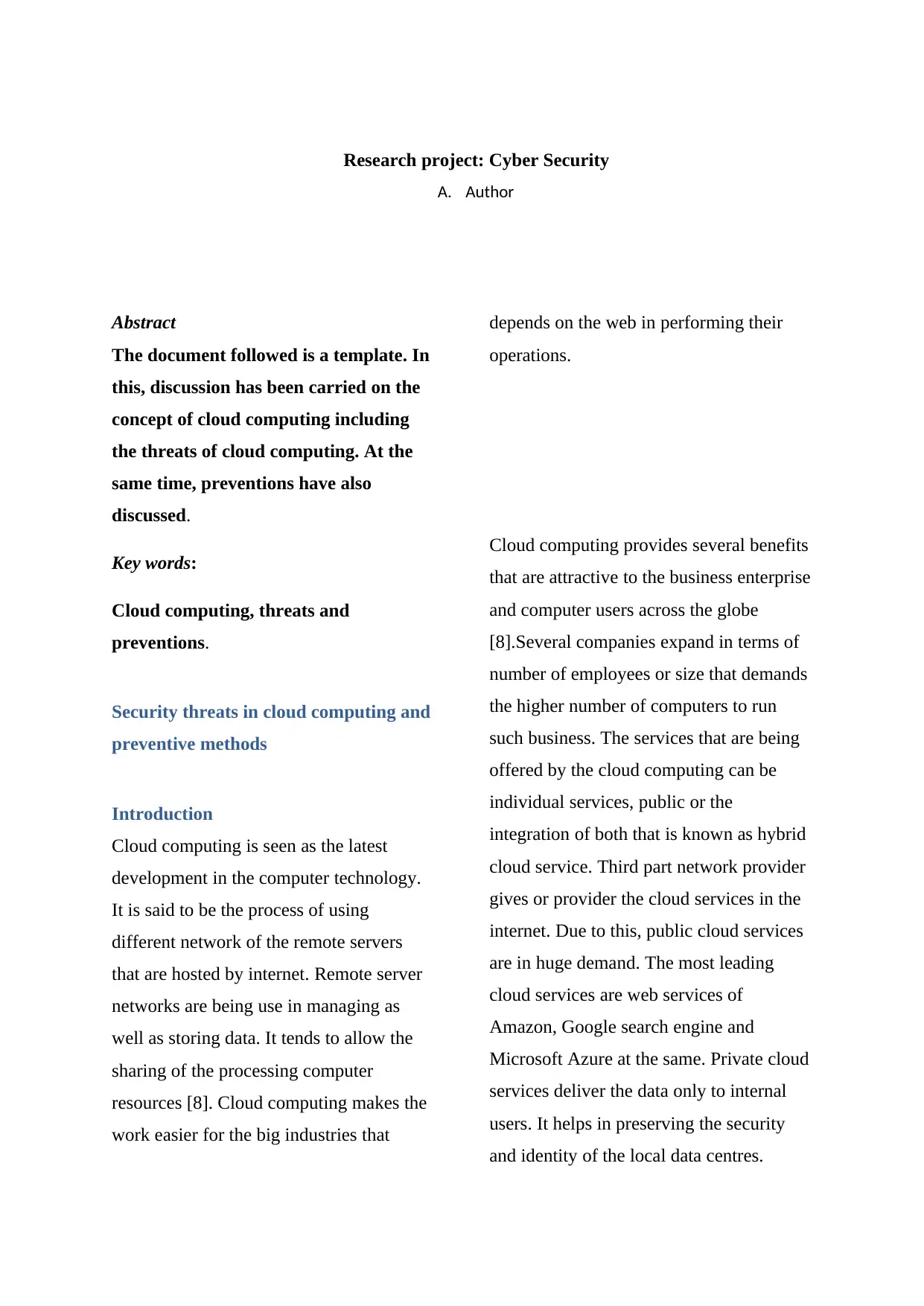
Research project: Cyber Security
A. Author
Abstract
The document followed is a template. In
this, discussion has been carried on the
concept of cloud computing including
the threats of cloud computing. At the
same time, preventions have also
discussed.
Key words:
Cloud computing, threats and
preventions.
Security threats in cloud computing and
preventive methods
Introduction
Cloud computing is seen as the latest
development in the computer technology.
It is said to be the process of using
different network of the remote servers
that are hosted by internet. Remote server
networks are being use in managing as
well as storing data. It tends to allow the
sharing of the processing computer
resources [8]. Cloud computing makes the
work easier for the big industries that
depends on the web in performing their
operations.
Cloud computing provides several benefits
that are attractive to the business enterprise
and computer users across the globe
[8].Several companies expand in terms of
number of employees or size that demands
the higher number of computers to run
such business. The services that are being
offered by the cloud computing can be
individual services, public or the
integration of both that is known as hybrid
cloud service. Third part network provider
gives or provider the cloud services in the
internet. Due to this, public cloud services
are in huge demand. The most leading
cloud services are web services of
Amazon, Google search engine and
Microsoft Azure at the same. Private cloud
services deliver the data only to internal
users. It helps in preserving the security
and identity of the local data centres.
A. Author
Abstract
The document followed is a template. In
this, discussion has been carried on the
concept of cloud computing including
the threats of cloud computing. At the
same time, preventions have also
discussed.
Key words:
Cloud computing, threats and
preventions.
Security threats in cloud computing and
preventive methods
Introduction
Cloud computing is seen as the latest
development in the computer technology.
It is said to be the process of using
different network of the remote servers
that are hosted by internet. Remote server
networks are being use in managing as
well as storing data. It tends to allow the
sharing of the processing computer
resources [8]. Cloud computing makes the
work easier for the big industries that
depends on the web in performing their
operations.
Cloud computing provides several benefits
that are attractive to the business enterprise
and computer users across the globe
[8].Several companies expand in terms of
number of employees or size that demands
the higher number of computers to run
such business. The services that are being
offered by the cloud computing can be
individual services, public or the
integration of both that is known as hybrid
cloud service. Third part network provider
gives or provider the cloud services in the
internet. Due to this, public cloud services
are in huge demand. The most leading
cloud services are web services of
Amazon, Google search engine and
Microsoft Azure at the same. Private cloud
services deliver the data only to internal
users. It helps in preserving the security
and identity of the local data centres.
Paraphrase This Document
Need a fresh take? Get an instant paraphrase of this document with our AI Paraphraser
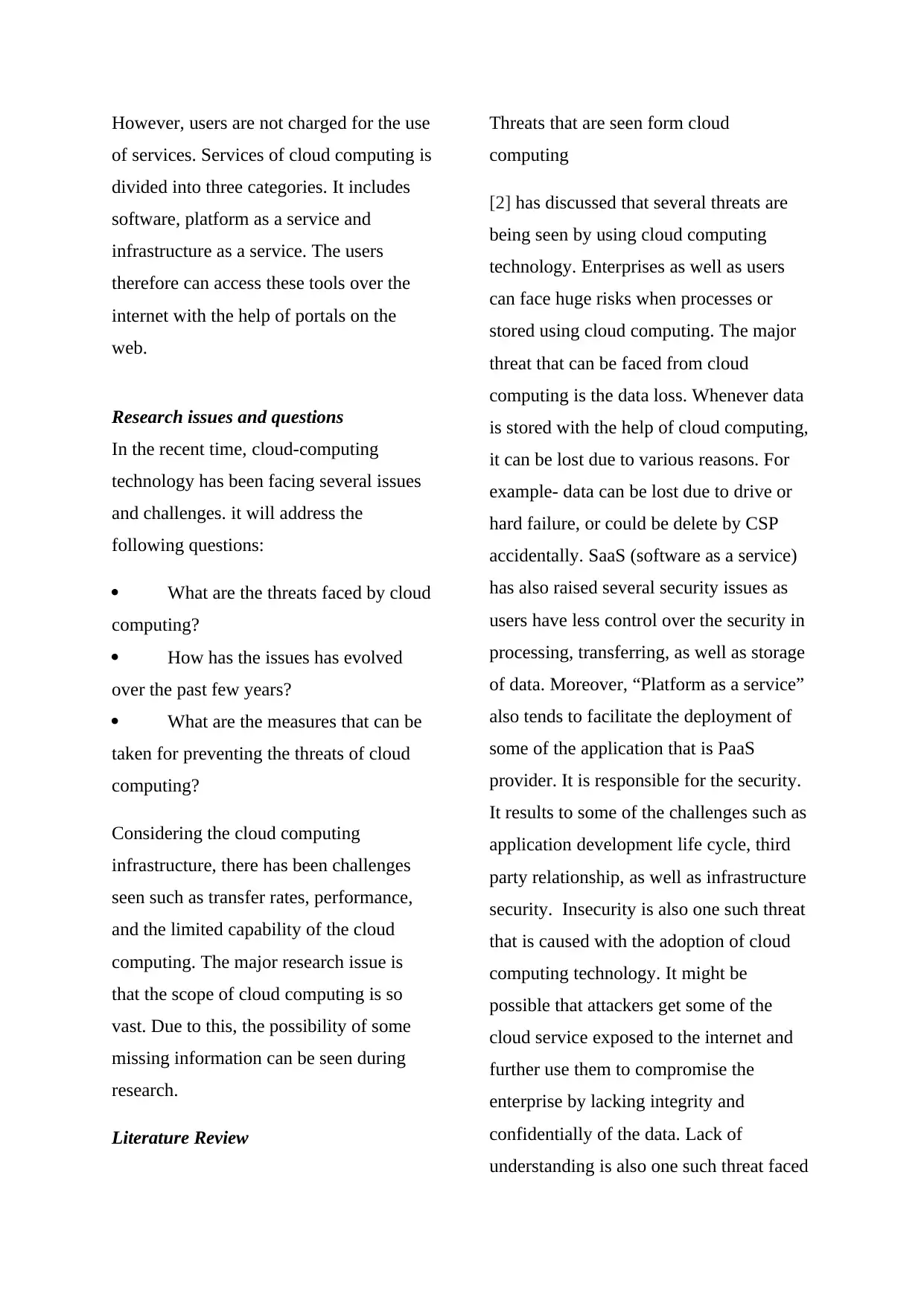
However, users are not charged for the use
of services. Services of cloud computing is
divided into three categories. It includes
software, platform as a service and
infrastructure as a service. The users
therefore can access these tools over the
internet with the help of portals on the
web.
Research issues and questions
In the recent time, cloud-computing
technology has been facing several issues
and challenges. it will address the
following questions:
What are the threats faced by cloud
computing?
How has the issues has evolved
over the past few years?
What are the measures that can be
taken for preventing the threats of cloud
computing?
Considering the cloud computing
infrastructure, there has been challenges
seen such as transfer rates, performance,
and the limited capability of the cloud
computing. The major research issue is
that the scope of cloud computing is so
vast. Due to this, the possibility of some
missing information can be seen during
research.
Literature Review
Threats that are seen form cloud
computing
[2] has discussed that several threats are
being seen by using cloud computing
technology. Enterprises as well as users
can face huge risks when processes or
stored using cloud computing. The major
threat that can be faced from cloud
computing is the data loss. Whenever data
is stored with the help of cloud computing,
it can be lost due to various reasons. For
example- data can be lost due to drive or
hard failure, or could be delete by CSP
accidentally. SaaS (software as a service)
has also raised several security issues as
users have less control over the security in
processing, transferring, as well as storage
of data. Moreover, “Platform as a service”
also tends to facilitate the deployment of
some of the application that is PaaS
provider. It is responsible for the security.
It results to some of the challenges such as
application development life cycle, third
party relationship, as well as infrastructure
security. Insecurity is also one such threat
that is caused with the adoption of cloud
computing technology. It might be
possible that attackers get some of the
cloud service exposed to the internet and
further use them to compromise the
enterprise by lacking integrity and
confidentially of the data. Lack of
understanding is also one such threat faced
of services. Services of cloud computing is
divided into three categories. It includes
software, platform as a service and
infrastructure as a service. The users
therefore can access these tools over the
internet with the help of portals on the
web.
Research issues and questions
In the recent time, cloud-computing
technology has been facing several issues
and challenges. it will address the
following questions:
What are the threats faced by cloud
computing?
How has the issues has evolved
over the past few years?
What are the measures that can be
taken for preventing the threats of cloud
computing?
Considering the cloud computing
infrastructure, there has been challenges
seen such as transfer rates, performance,
and the limited capability of the cloud
computing. The major research issue is
that the scope of cloud computing is so
vast. Due to this, the possibility of some
missing information can be seen during
research.
Literature Review
Threats that are seen form cloud
computing
[2] has discussed that several threats are
being seen by using cloud computing
technology. Enterprises as well as users
can face huge risks when processes or
stored using cloud computing. The major
threat that can be faced from cloud
computing is the data loss. Whenever data
is stored with the help of cloud computing,
it can be lost due to various reasons. For
example- data can be lost due to drive or
hard failure, or could be delete by CSP
accidentally. SaaS (software as a service)
has also raised several security issues as
users have less control over the security in
processing, transferring, as well as storage
of data. Moreover, “Platform as a service”
also tends to facilitate the deployment of
some of the application that is PaaS
provider. It is responsible for the security.
It results to some of the challenges such as
application development life cycle, third
party relationship, as well as infrastructure
security. Insecurity is also one such threat
that is caused with the adoption of cloud
computing technology. It might be
possible that attackers get some of the
cloud service exposed to the internet and
further use them to compromise the
enterprise by lacking integrity and
confidentially of the data. Lack of
understanding is also one such threat faced
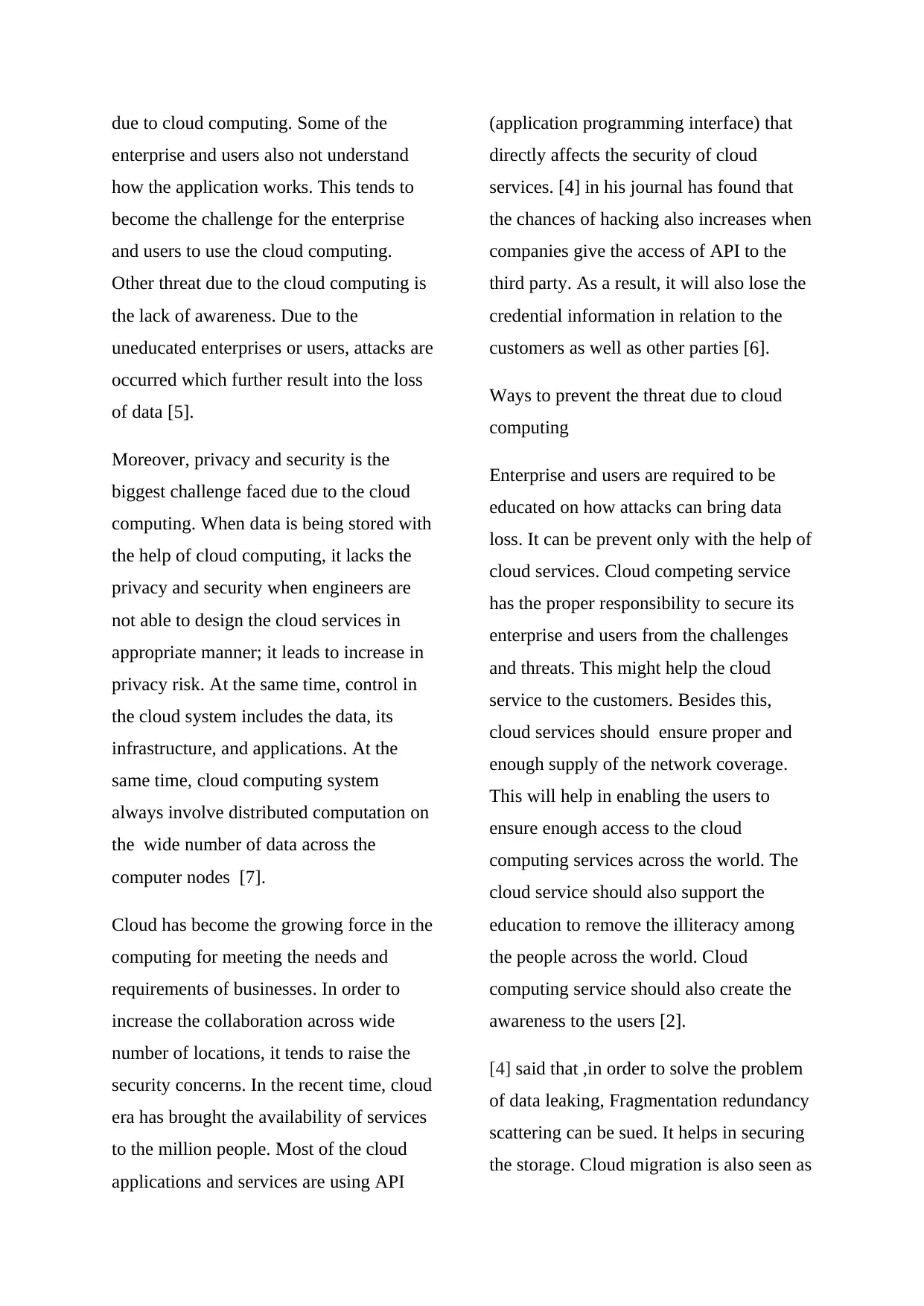
due to cloud computing. Some of the
enterprise and users also not understand
how the application works. This tends to
become the challenge for the enterprise
and users to use the cloud computing.
Other threat due to the cloud computing is
the lack of awareness. Due to the
uneducated enterprises or users, attacks are
occurred which further result into the loss
of data [5].
Moreover, privacy and security is the
biggest challenge faced due to the cloud
computing. When data is being stored with
the help of cloud computing, it lacks the
privacy and security when engineers are
not able to design the cloud services in
appropriate manner; it leads to increase in
privacy risk. At the same time, control in
the cloud system includes the data, its
infrastructure, and applications. At the
same time, cloud computing system
always involve distributed computation on
the wide number of data across the
computer nodes [7].
Cloud has become the growing force in the
computing for meeting the needs and
requirements of businesses. In order to
increase the collaboration across wide
number of locations, it tends to raise the
security concerns. In the recent time, cloud
era has brought the availability of services
to the million people. Most of the cloud
applications and services are using API
(application programming interface) that
directly affects the security of cloud
services. [4] in his journal has found that
the chances of hacking also increases when
companies give the access of API to the
third party. As a result, it will also lose the
credential information in relation to the
customers as well as other parties [6].
Ways to prevent the threat due to cloud
computing
Enterprise and users are required to be
educated on how attacks can bring data
loss. It can be prevent only with the help of
cloud services. Cloud competing service
has the proper responsibility to secure its
enterprise and users from the challenges
and threats. This might help the cloud
service to the customers. Besides this,
cloud services should ensure proper and
enough supply of the network coverage.
This will help in enabling the users to
ensure enough access to the cloud
computing services across the world. The
cloud service should also support the
education to remove the illiteracy among
the people across the world. Cloud
computing service should also create the
awareness to the users [2].
[4] said that ,in order to solve the problem
of data leaking, Fragmentation redundancy
scattering can be sued. It helps in securing
the storage. Cloud migration is also seen as
enterprise and users also not understand
how the application works. This tends to
become the challenge for the enterprise
and users to use the cloud computing.
Other threat due to the cloud computing is
the lack of awareness. Due to the
uneducated enterprises or users, attacks are
occurred which further result into the loss
of data [5].
Moreover, privacy and security is the
biggest challenge faced due to the cloud
computing. When data is being stored with
the help of cloud computing, it lacks the
privacy and security when engineers are
not able to design the cloud services in
appropriate manner; it leads to increase in
privacy risk. At the same time, control in
the cloud system includes the data, its
infrastructure, and applications. At the
same time, cloud computing system
always involve distributed computation on
the wide number of data across the
computer nodes [7].
Cloud has become the growing force in the
computing for meeting the needs and
requirements of businesses. In order to
increase the collaboration across wide
number of locations, it tends to raise the
security concerns. In the recent time, cloud
era has brought the availability of services
to the million people. Most of the cloud
applications and services are using API
(application programming interface) that
directly affects the security of cloud
services. [4] in his journal has found that
the chances of hacking also increases when
companies give the access of API to the
third party. As a result, it will also lose the
credential information in relation to the
customers as well as other parties [6].
Ways to prevent the threat due to cloud
computing
Enterprise and users are required to be
educated on how attacks can bring data
loss. It can be prevent only with the help of
cloud services. Cloud competing service
has the proper responsibility to secure its
enterprise and users from the challenges
and threats. This might help the cloud
service to the customers. Besides this,
cloud services should ensure proper and
enough supply of the network coverage.
This will help in enabling the users to
ensure enough access to the cloud
computing services across the world. The
cloud service should also support the
education to remove the illiteracy among
the people across the world. Cloud
computing service should also create the
awareness to the users [2].
[4] said that ,in order to solve the problem
of data leaking, Fragmentation redundancy
scattering can be sued. It helps in securing
the storage. Cloud migration is also seen as
⊘ This is a preview!⊘
Do you want full access?
Subscribe today to unlock all pages.

Trusted by 1+ million students worldwide
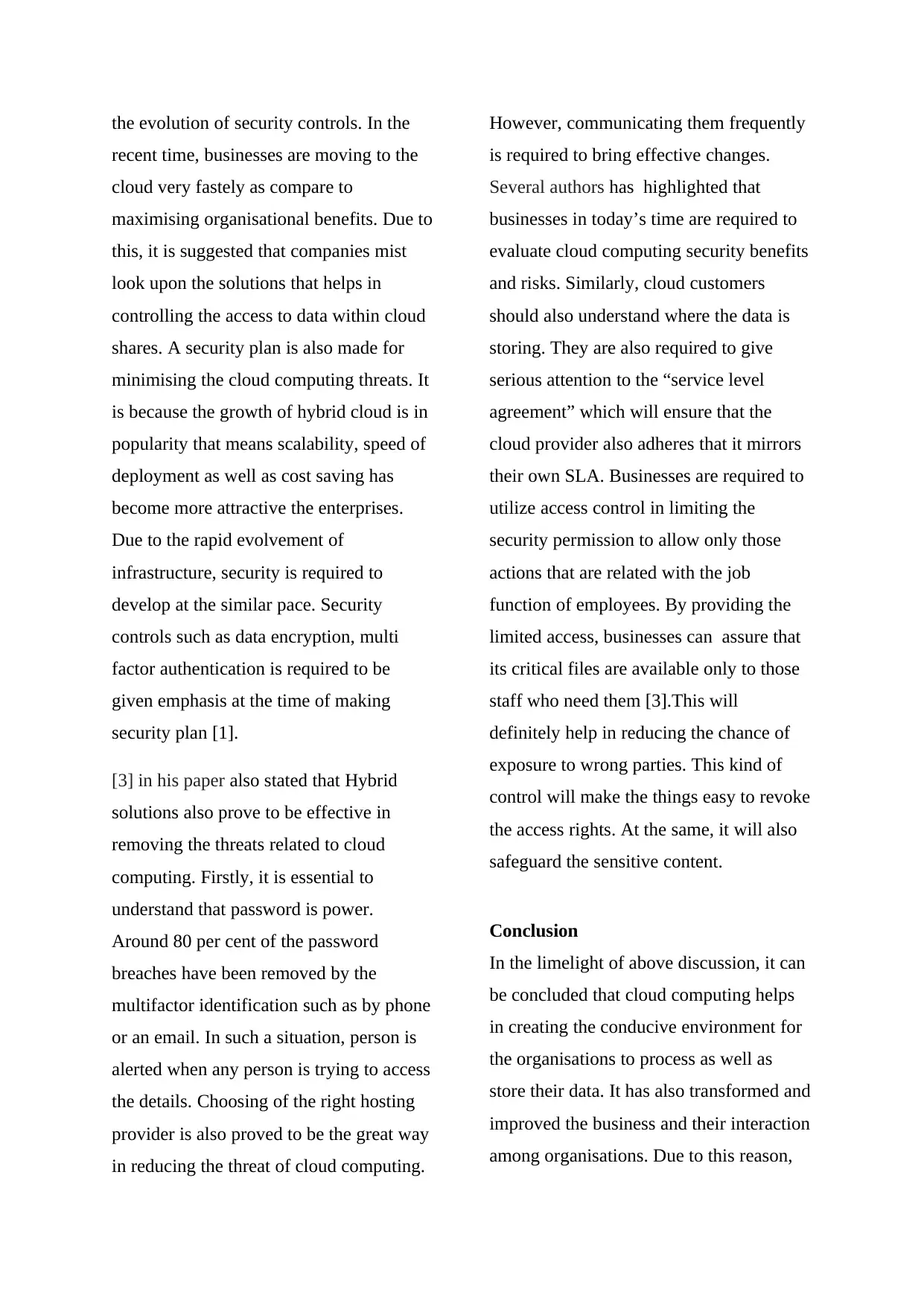
the evolution of security controls. In the
recent time, businesses are moving to the
cloud very fastely as compare to
maximising organisational benefits. Due to
this, it is suggested that companies mist
look upon the solutions that helps in
controlling the access to data within cloud
shares. A security plan is also made for
minimising the cloud computing threats. It
is because the growth of hybrid cloud is in
popularity that means scalability, speed of
deployment as well as cost saving has
become more attractive the enterprises.
Due to the rapid evolvement of
infrastructure, security is required to
develop at the similar pace. Security
controls such as data encryption, multi
factor authentication is required to be
given emphasis at the time of making
security plan [1].
[3] in his paper also stated that Hybrid
solutions also prove to be effective in
removing the threats related to cloud
computing. Firstly, it is essential to
understand that password is power.
Around 80 per cent of the password
breaches have been removed by the
multifactor identification such as by phone
or an email. In such a situation, person is
alerted when any person is trying to access
the details. Choosing of the right hosting
provider is also proved to be the great way
in reducing the threat of cloud computing.
However, communicating them frequently
is required to bring effective changes.
Several authors has highlighted that
businesses in today’s time are required to
evaluate cloud computing security benefits
and risks. Similarly, cloud customers
should also understand where the data is
storing. They are also required to give
serious attention to the “service level
agreement” which will ensure that the
cloud provider also adheres that it mirrors
their own SLA. Businesses are required to
utilize access control in limiting the
security permission to allow only those
actions that are related with the job
function of employees. By providing the
limited access, businesses can assure that
its critical files are available only to those
staff who need them [3].This will
definitely help in reducing the chance of
exposure to wrong parties. This kind of
control will make the things easy to revoke
the access rights. At the same, it will also
safeguard the sensitive content.
Conclusion
In the limelight of above discussion, it can
be concluded that cloud computing helps
in creating the conducive environment for
the organisations to process as well as
store their data. It has also transformed and
improved the business and their interaction
among organisations. Due to this reason,
recent time, businesses are moving to the
cloud very fastely as compare to
maximising organisational benefits. Due to
this, it is suggested that companies mist
look upon the solutions that helps in
controlling the access to data within cloud
shares. A security plan is also made for
minimising the cloud computing threats. It
is because the growth of hybrid cloud is in
popularity that means scalability, speed of
deployment as well as cost saving has
become more attractive the enterprises.
Due to the rapid evolvement of
infrastructure, security is required to
develop at the similar pace. Security
controls such as data encryption, multi
factor authentication is required to be
given emphasis at the time of making
security plan [1].
[3] in his paper also stated that Hybrid
solutions also prove to be effective in
removing the threats related to cloud
computing. Firstly, it is essential to
understand that password is power.
Around 80 per cent of the password
breaches have been removed by the
multifactor identification such as by phone
or an email. In such a situation, person is
alerted when any person is trying to access
the details. Choosing of the right hosting
provider is also proved to be the great way
in reducing the threat of cloud computing.
However, communicating them frequently
is required to bring effective changes.
Several authors has highlighted that
businesses in today’s time are required to
evaluate cloud computing security benefits
and risks. Similarly, cloud customers
should also understand where the data is
storing. They are also required to give
serious attention to the “service level
agreement” which will ensure that the
cloud provider also adheres that it mirrors
their own SLA. Businesses are required to
utilize access control in limiting the
security permission to allow only those
actions that are related with the job
function of employees. By providing the
limited access, businesses can assure that
its critical files are available only to those
staff who need them [3].This will
definitely help in reducing the chance of
exposure to wrong parties. This kind of
control will make the things easy to revoke
the access rights. At the same, it will also
safeguard the sensitive content.
Conclusion
In the limelight of above discussion, it can
be concluded that cloud computing helps
in creating the conducive environment for
the organisations to process as well as
store their data. It has also transformed and
improved the business and their interaction
among organisations. Due to this reason,
Paraphrase This Document
Need a fresh take? Get an instant paraphrase of this document with our AI Paraphraser
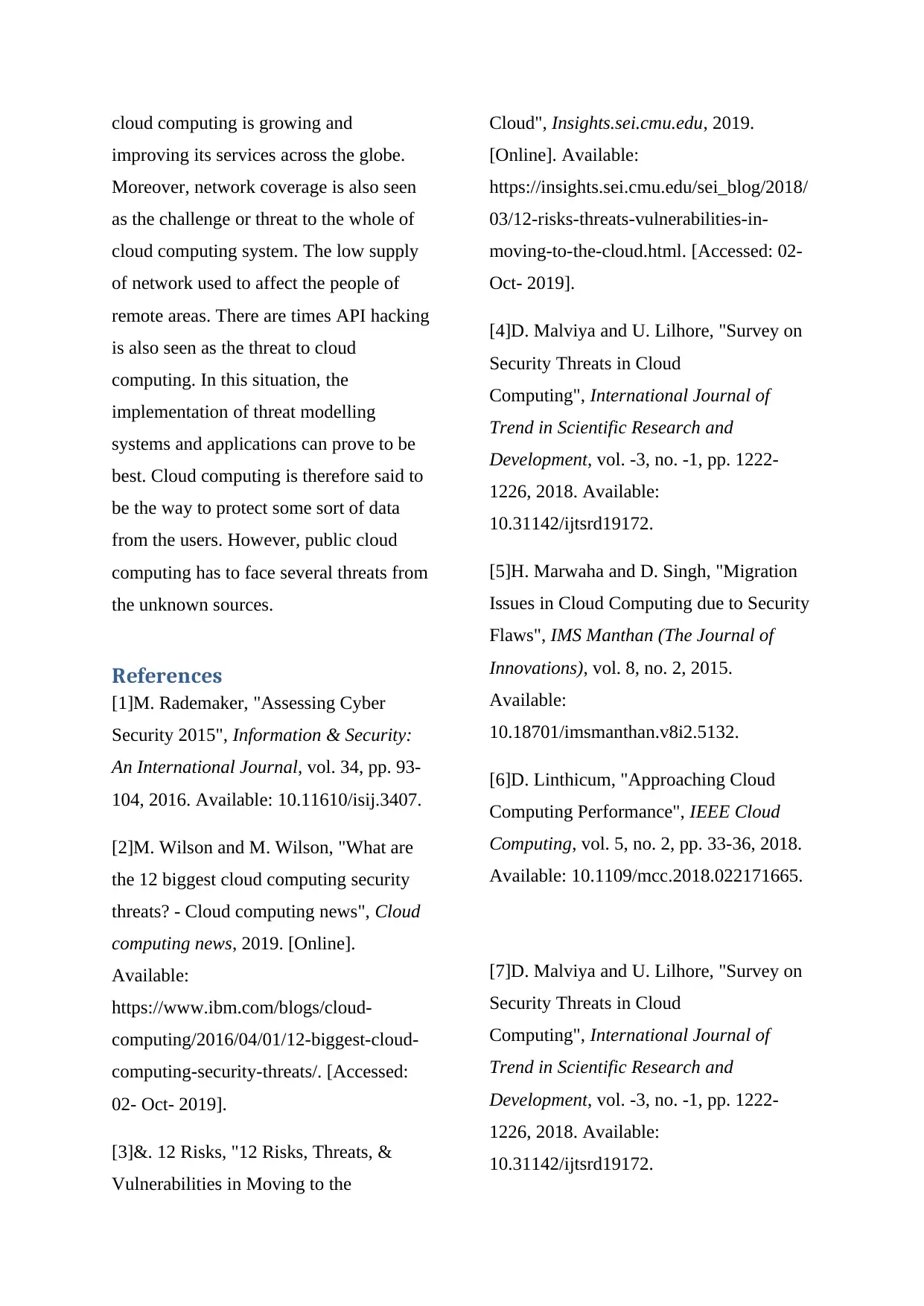
cloud computing is growing and
improving its services across the globe.
Moreover, network coverage is also seen
as the challenge or threat to the whole of
cloud computing system. The low supply
of network used to affect the people of
remote areas. There are times API hacking
is also seen as the threat to cloud
computing. In this situation, the
implementation of threat modelling
systems and applications can prove to be
best. Cloud computing is therefore said to
be the way to protect some sort of data
from the users. However, public cloud
computing has to face several threats from
the unknown sources.
References
[1]M. Rademaker, "Assessing Cyber
Security 2015", Information & Security:
An International Journal, vol. 34, pp. 93-
104, 2016. Available: 10.11610/isij.3407.
[2]M. Wilson and M. Wilson, "What are
the 12 biggest cloud computing security
threats? - Cloud computing news", Cloud
computing news, 2019. [Online].
Available:
https://www.ibm.com/blogs/cloud-
computing/2016/04/01/12-biggest-cloud-
computing-security-threats/. [Accessed:
02- Oct- 2019].
[3]&. 12 Risks, "12 Risks, Threats, &
Vulnerabilities in Moving to the
Cloud", Insights.sei.cmu.edu, 2019.
[Online]. Available:
https://insights.sei.cmu.edu/sei_blog/2018/
03/12-risks-threats-vulnerabilities-in-
moving-to-the-cloud.html. [Accessed: 02-
Oct- 2019].
[4]D. Malviya and U. Lilhore, "Survey on
Security Threats in Cloud
Computing", International Journal of
Trend in Scientific Research and
Development, vol. -3, no. -1, pp. 1222-
1226, 2018. Available:
10.31142/ijtsrd19172.
[5]H. Marwaha and D. Singh, "Migration
Issues in Cloud Computing due to Security
Flaws", IMS Manthan (The Journal of
Innovations), vol. 8, no. 2, 2015.
Available:
10.18701/imsmanthan.v8i2.5132.
[6]D. Linthicum, "Approaching Cloud
Computing Performance", IEEE Cloud
Computing, vol. 5, no. 2, pp. 33-36, 2018.
Available: 10.1109/mcc.2018.022171665.
[7]D. Malviya and U. Lilhore, "Survey on
Security Threats in Cloud
Computing", International Journal of
Trend in Scientific Research and
Development, vol. -3, no. -1, pp. 1222-
1226, 2018. Available:
10.31142/ijtsrd19172.
improving its services across the globe.
Moreover, network coverage is also seen
as the challenge or threat to the whole of
cloud computing system. The low supply
of network used to affect the people of
remote areas. There are times API hacking
is also seen as the threat to cloud
computing. In this situation, the
implementation of threat modelling
systems and applications can prove to be
best. Cloud computing is therefore said to
be the way to protect some sort of data
from the users. However, public cloud
computing has to face several threats from
the unknown sources.
References
[1]M. Rademaker, "Assessing Cyber
Security 2015", Information & Security:
An International Journal, vol. 34, pp. 93-
104, 2016. Available: 10.11610/isij.3407.
[2]M. Wilson and M. Wilson, "What are
the 12 biggest cloud computing security
threats? - Cloud computing news", Cloud
computing news, 2019. [Online].
Available:
https://www.ibm.com/blogs/cloud-
computing/2016/04/01/12-biggest-cloud-
computing-security-threats/. [Accessed:
02- Oct- 2019].
[3]&. 12 Risks, "12 Risks, Threats, &
Vulnerabilities in Moving to the
Cloud", Insights.sei.cmu.edu, 2019.
[Online]. Available:
https://insights.sei.cmu.edu/sei_blog/2018/
03/12-risks-threats-vulnerabilities-in-
moving-to-the-cloud.html. [Accessed: 02-
Oct- 2019].
[4]D. Malviya and U. Lilhore, "Survey on
Security Threats in Cloud
Computing", International Journal of
Trend in Scientific Research and
Development, vol. -3, no. -1, pp. 1222-
1226, 2018. Available:
10.31142/ijtsrd19172.
[5]H. Marwaha and D. Singh, "Migration
Issues in Cloud Computing due to Security
Flaws", IMS Manthan (The Journal of
Innovations), vol. 8, no. 2, 2015.
Available:
10.18701/imsmanthan.v8i2.5132.
[6]D. Linthicum, "Approaching Cloud
Computing Performance", IEEE Cloud
Computing, vol. 5, no. 2, pp. 33-36, 2018.
Available: 10.1109/mcc.2018.022171665.
[7]D. Malviya and U. Lilhore, "Survey on
Security Threats in Cloud
Computing", International Journal of
Trend in Scientific Research and
Development, vol. -3, no. -1, pp. 1222-
1226, 2018. Available:
10.31142/ijtsrd19172.
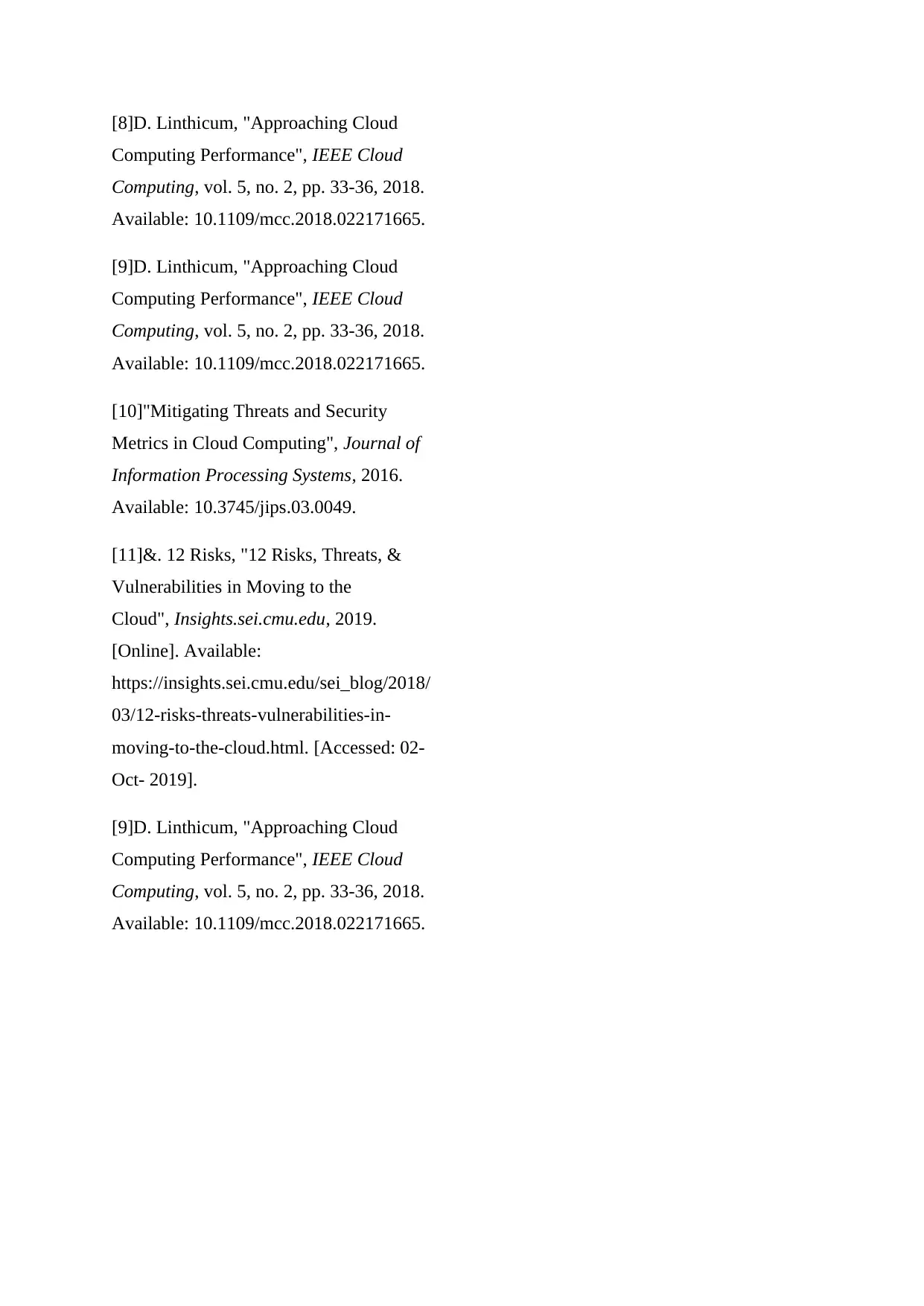
[8]D. Linthicum, "Approaching Cloud
Computing Performance", IEEE Cloud
Computing, vol. 5, no. 2, pp. 33-36, 2018.
Available: 10.1109/mcc.2018.022171665.
[9]D. Linthicum, "Approaching Cloud
Computing Performance", IEEE Cloud
Computing, vol. 5, no. 2, pp. 33-36, 2018.
Available: 10.1109/mcc.2018.022171665.
[10]"Mitigating Threats and Security
Metrics in Cloud Computing", Journal of
Information Processing Systems, 2016.
Available: 10.3745/jips.03.0049.
[11]&. 12 Risks, "12 Risks, Threats, &
Vulnerabilities in Moving to the
Cloud", Insights.sei.cmu.edu, 2019.
[Online]. Available:
https://insights.sei.cmu.edu/sei_blog/2018/
03/12-risks-threats-vulnerabilities-in-
moving-to-the-cloud.html. [Accessed: 02-
Oct- 2019].
[9]D. Linthicum, "Approaching Cloud
Computing Performance", IEEE Cloud
Computing, vol. 5, no. 2, pp. 33-36, 2018.
Available: 10.1109/mcc.2018.022171665.
Computing Performance", IEEE Cloud
Computing, vol. 5, no. 2, pp. 33-36, 2018.
Available: 10.1109/mcc.2018.022171665.
[9]D. Linthicum, "Approaching Cloud
Computing Performance", IEEE Cloud
Computing, vol. 5, no. 2, pp. 33-36, 2018.
Available: 10.1109/mcc.2018.022171665.
[10]"Mitigating Threats and Security
Metrics in Cloud Computing", Journal of
Information Processing Systems, 2016.
Available: 10.3745/jips.03.0049.
[11]&. 12 Risks, "12 Risks, Threats, &
Vulnerabilities in Moving to the
Cloud", Insights.sei.cmu.edu, 2019.
[Online]. Available:
https://insights.sei.cmu.edu/sei_blog/2018/
03/12-risks-threats-vulnerabilities-in-
moving-to-the-cloud.html. [Accessed: 02-
Oct- 2019].
[9]D. Linthicum, "Approaching Cloud
Computing Performance", IEEE Cloud
Computing, vol. 5, no. 2, pp. 33-36, 2018.
Available: 10.1109/mcc.2018.022171665.
⊘ This is a preview!⊘
Do you want full access?
Subscribe today to unlock all pages.

Trusted by 1+ million students worldwide
1 out of 6
Related Documents
Your All-in-One AI-Powered Toolkit for Academic Success.
+13062052269
info@desklib.com
Available 24*7 on WhatsApp / Email
![[object Object]](/_next/static/media/star-bottom.7253800d.svg)
Unlock your academic potential
Copyright © 2020–2025 A2Z Services. All Rights Reserved. Developed and managed by ZUCOL.




